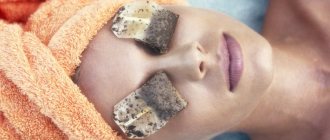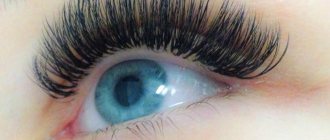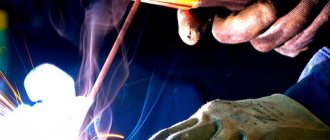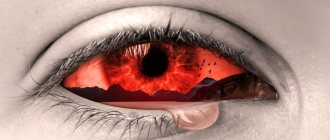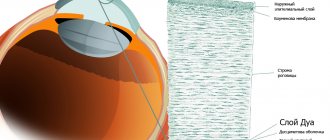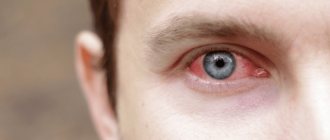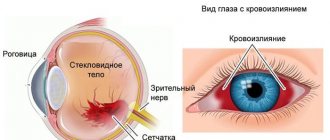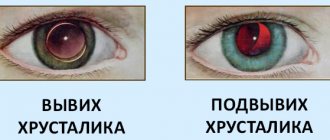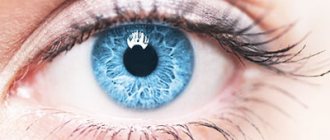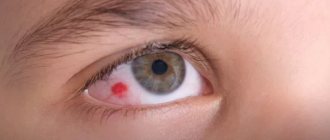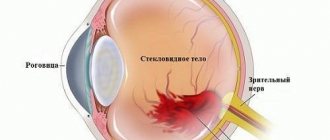Dangers
Metal particles also cause severe eye irritation. For example, a person knocks on metal with a hammer, and at some point notices that a speck seems to have gotten into his eye, but in fact it is a microscopic fragment of metal. The victim does not attach much importance to this at first, but after a few days he notices that his vision has begun to noticeably deteriorate. This is due to the fact that a piece of metal, which accidentally penetrated into the eye, began to oxidize.
The most dangerous in this sense is copper, which oxidizes more quickly and has a strong toxic effect on the cornea. This leads to damage to the retina, lens, optic nerve and ultimately to irreversible loss of vision. Therefore, in cases where a foreign body gets into the eye, you need to immediately contact an ophthalmologist and carry out timely treatment.
How to remove a foreign body from the eye
To begin with, it’s worth talking about what not to do if a foreign body gets into the eye. Firstly, you should not rub your eye, since in this way you can only drive the speck that gets into it even deeper or even injure your eye. Secondly, you should not blink or close your eyes too often. Thirdly, traditional methods cannot be used as treatment, for example, you should not drip honey with aloe juice into your eyes.
Can't stop
After this, it is good to drip eye drops: chloramphenicol or albucid: for adults - a 30% solution, for children - a solution of a lower concentration. Even if the pain gradually disappears after instillation, treatment should not be stopped. It is necessary to continue instillation every 2 - 2.5 hours on the first day and three times a day in subsequent days.
Dexamethasone and Taufon drops will help remove residual redness of the protein. But keep in mind: without consulting a doctor, drops should not be used for more than a few days.
So, how to remove a foreign body?
1. It is best if there is another person nearby who can help you remove the stuck speck from your eye. If there is no one nearby and you have to cope on your own, then it is advisable to have a mirror with you for greater convenience. 2. The first thing you need to do is determine where the speck is located - to do this, blink several times so that you can feel the sensations and understand where exactly it is located - under the upper or lower eyelid. 3. If you still cannot identify its location, try to find the speck by carefully examining the lower and upper eyelids. To do this, stand in front of a mirror and gently pull your lower eyelid down and examine it carefully. If a foreign body is not detected, do the same with the upper eyelid, only in this case, gently pull it up.
4. After the particle that has entered the eye has been found, it is necessary to carefully remove it from the eye using a cotton swab or a clean handkerchief. Next, rinse your eyes well with water. 5. The last thing to do is to drip eye drops, for example, Levomycetin or Tobrex. The drops should be used up to four times a day, one drop at a time. The course of treatment is a couple of weeks. Eye drops help relieve irritation and speed up healing of the cornea. Before using medications, it is advisable to consult an ophthalmologist.
Small particles in the eye
If there are a lot of small particles in the eye (such as dirt or sand), first clean the skin around the eye with a damp sponge. Then ask the child to dip the injured side of his face in a container of water and at the same time blink his eye (open and close it several times).
If your child is too young for this task, try another option: hold your baby gently, face up, under a warm (not high pressure) tap, or simply gently pour warm water over the eye. The eyelids must be open during the procedure.
Group of medicines
Drops for eye injuries are prescribed by doctor and are used depending on the nature of the injury. The most popular and effective drugs:
- Tobropt is an instillation liquid with antibacterial properties. The active substance of the drug is a potent broad-spectrum antibiotic of the tobramycin group. The drug is mainly used to treat purulent and inflammatory processes.
- Khilozar-comodo is an ophthalmic moisturizing agent. Used to eliminate dryness of the eye shell, relieves irritation. The solution is recommended for people wearing contact lenses or glasses.
- Naklof - topical drops have a narrow focus. Produced by Swiss pharmacology, they have an analgesic effect, and are mainly used for eye surgeries.
- Okomistin - the medicine has a wide spectrum of antiseptic action. It is used mainly to remove foci of infection that have a large area affected (conjunctivitis, iridocyclitis, keratouveitis). Okomistin is also instilled before and after surgery for preventive purposes.
- Oftan Dexamethasone - used to eliminate inflammatory and allergic processes. The drug is dispensed strictly according to a doctor's prescription, since it contains hormonal elements. If the dosage is exceeded, the drops can have the opposite effect of treatment - the development of viral and fungal infections.
- Combinil Duo is a synthesized drug derived by mixing ciprofloxacin and dexamethasone. Used for the prevention and treatment of acute blepharitis and conjunctivitis. The liquid has a yellowish color and is bottled in 5 ml bottles.
- Gentamicin is a drop that has been on the pharmacological market for a long time. Before use, it is recommended to consult your doctor. If the dosage is not observed or the individual sensitivity of the body to the composition of the drug, fungus of the lacrimal canal may develop.
- Balarpan - the spectrum of action of the drops is aimed at the cornea. The drug contains glycosaminoglycans (components of the connective tissue of the cornea). Balarpan is used mainly to eliminate the consequences of chemical and thermal burns, non-penetrating wounds, as well as in the postoperative period.
- Alcaine is a potent analgesic. Used for short-term anesthesia of the eyeball for quick interventions, for example, removal of foreign bodies. Contains proxymethocaine.
- Adgelon – solution with gliprotein (0.01%). The liquid helps restore the cellular structure of damaged layers of the eyeball caused by aging or direct damage. Available in 5 ml bottles, the medicine has a transparent color.
- Prenacid - drops made in Italy. They are a hormonal drug, their actions are aimed at suppressing inflammatory processes and allergies. It is available only by prescription, since overdose and improper use will only worsen the condition (can provoke the development of an infectious focus).
- Catalin is a powerful tool that helps restore the natural metabolic processes of the eye membrane. Significantly slows down the development of cataracts, and also prevents its development at an early stage. Helps dissolve protein deposits in secretions.
Keep your eyes open
But the conversation in the editorial office began with... the summer season.
Mikhail Egorovich, townspeople are now going to their dachas. And, we know, involuntary “victims” of various works on the ground have already appeared in the clinic. How to open and spend the summer season without harm to your eyes?
Mikhail Konovalov:
Most of us are summer residents. For a certain period, we become people who engage in agriculture. Me included.
With such and such hands?
Mikhail Konovalov:
Yes. Although physical labor does not have a very beneficial effect on the hands of a microsurgeon, if everything is dosed, then it is not scary.
Do you wear gloves?
Mikhail Konovalov:
Necessarily. But if we talk about the eyes, then any injury is dangerous for them. The first injury is simply the entry of dust and earth into the conjunctival cavity. This can cause simple conjunctivitis, that is, inflammation of the outer layer of the eye, the conjunctiva. The eye will turn red, there will be a feeling of a foreign body, lacrimation. Therefore, at the dacha there should be a banal set of drops. The simplest ones are our Russian ones, albucid. That is, if it is conjunctivitis, or a foreign object has entered the conjunctival cavity, then you need to instill more of these drops.
More - how much?
Mikhail Konovalov:
2-5 or even 10 drops. And, in general, that’s where it all ends. The second option: if, say, a grain of sand or sand particles gets into the eye. They can damage the cornea. Typically, the outer layer of the cornea, called the epithelium, is affected. The cornea is a very sensitive tissue. If even a fraction of a millimeter of its area is exposed, then the symptoms are already more severe: in addition to lacrimation - photophobia, reluctance to open this eye. This is the so-called corneal erosion. Here the treatment is different.
The first thing to do is to instill disinfectant drops or antibiotics. The fact is that a bare surface is like tearing off a piece of skin on the body. Accordingly, infection can occur more easily. Therefore, it is necessary to instill antibiotics and drugs that improve tissue regeneration. That is, healing. There are many such drugs, ranging from artificial tears, drops and ending with solcoseryl. These are more viscous drugs and are sold in tubes. And, as a rule, they help.
Can these antibiotics be bought without a prescription?
Mikhail Konovalov:
Yes. The third option: when we cut or cut branches, and their derivative gets into the eye cavity. Blunt trauma occurs. As a rule, this ends again in erosion. And the treatment is about the same. We must remember: if there is serious work to be done - chopping wood, hammering nails, manipulating with a sledgehammer, then you need to wear special safety glasses. Because the most dangerous injuries occur when a small particle of an iron object flies off. It flies very fast, it is very sharp and easily pierces the eye.
The most dangerous eye injuries occur in the countryside when chopping wood or working with metal, when small fragments fly off
Depending on the impact and impact, location, the fragment may get stuck in the sclera - the white part of the eye, which is quite dense. This is the best variant. It can also get stuck in the cornea - that’s also not a big deal: it can be removed from there. But if it flies further, then this is already a penetrating wound. The integrity of the eye is compromised. And if the impact is very strong, then the particle flies into the vitreous cavity all the way to the retina.
Banal injuries are usually easy to treat. Even if the fragment gets into the cornea. A patient comes to see a doctor. The doctor drops anesthetic drops, and using a regular injection needle, this fragment is removed under a slit lamp.
But is it necessary to see a doctor in this case?
Mikhail Konovalov:
Certainly. In addition, when people saw metal, hot pieces of metal fly off. A typical injury is possible: a fragment enters the cornea and a small burn forms around it. It can be removed with an injection needle. And that's where it all ends. But again, drops, antibiotics are necessary. In any case, everyone should remember safety precautions. Because there are such injuries, they are quite common. This means that when leaving for the country, it is advisable to have with you a certain set of medications that should always be with you. And don't forget about safety glasses.
Read more about the “Business Breakfast” with Professor Mikhail Konovalov in one of the upcoming issues of RG.
